Air gun
An air gun (or airgun) is any kind of gun that launches projectiles pneumatically with compressed air or other gases that are pressurized mechanically without involving any chemical reactions, in contrast to a firearm, which pressurizes gases chemically via an exothermic oxidation (deflagration) of combustible propellants which generates propulsive energy by breaking molecular bonds. Both the long gun and handgun forms (air rifle and air pistol) typically propel metallic projectiles, that are either diabolo-shaped pellets, or spherical shots called BBs. Certain types of air guns (usually rifles) may also propel darts or arrows.
The first air guns were developed as early as the 1500s. They have been used in hunting, sporting and warfare. Modern air guns use one of three types of power source depending on the design: spring-piston, pneumatic, and bottled compressed gas (most commonly carbon dioxide).
History

Air guns represent the oldest pneumatic technology. The oldest existing mechanical air gun, a bellows air gun dating back to about 1580, is in the Livrustkammaren Museum in Stockholm. This is the time most historians recognize as the beginning of the modern air gun.
Throughout 17th to 19th century, air guns in calibers .30–.51, were used to hunt big-game deer and wild boar. These air rifles were charged using a pump to fill an air reservoir and gave velocities from 650 to 1,000 feet per second (200–300 m/s). They were also used in warfare, the most recognized example being the Girandoni air rifle.
At that time, they had compelling advantages over the primitive firearms of the day. For example, air guns could be discharged in wet weather and rain (unlike both matchlock and flintlock muskets), and discharged much faster than muzzle-loading guns.[1] Moreover, they were quieter than a firearm of similar caliber, had no muzzle flash, and were smokeless. Thus, they did not disclose the shooter's position or obscure the shooter's view, unlike the black powder muskets of the 18th and 19th centuries.
In the hands of skilled soldiers, they gave the military a distinct advantage. France, Austria and other nations had special sniper detachments using air rifles. The Austrian 1770 model was named Windbüchse (literally "wind rifle" in German). The gun was developed in 1768 or 1769[2] by the Tyrolean watchmaker, mechanic and gunsmith Bartholomäus Girandoni (1744–1799) and is sometimes referred to as the Girandoni air rifle or Girandoni air gun in literature (the name is also spelled "Girandony," "Giradoni"[3] or "Girardoni".[4]) The Windbüchse was about 4 ft (1.2 m) long and weighed 10 pounds (4.5 kg), about the same size and mass as a conventional musket. The air reservoir was a removable, club-shaped, butt. The Windbüchse carried twenty-two .51 caliber (13 mm) lead balls in a tubular magazine. A skilled shooter could fire off one magazine in about thirty seconds. A shot from this air gun could penetrate an inch thick wooden board at a hundred paces, an effect roughly equal to that of a modern 9×19mm or .45 ACP caliber pistol.
Circa 1820, the Japanese inventor Kunitomo Ikkansai developed various manufacturing methods for guns, and also created an air gun based on the study of Western knowledge ("rangaku") acquired from the Dutch in Dejima.
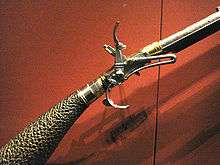
The celebrated Lewis and Clark Expedition (1804) carried a reservoir air gun. It held 22 .46 caliber round balls in a tubular magazine mounted on the side of the barrel. The butt served as the air reservoir and had a working pressure of 800 psi (55 bar). The rifle was said to be capable of 22 aimed shots per minute and had a rifled bore of 0.452 in (11.5 mm) and a groove diameter 0.462 in (11.7 mm).
One of the first commercially successful and mass-produced air guns was manufactured by the William F. Markham's Markham Air Rifle Company in Plymouth, Michigan. Their first model air gun was the wooden Challenger and marketed in 1886. In response, Clarence Hamilton from the neighboring Plymouth Air Rifle Company (later renamed to Daisy Manufacturing Company in 1895) marketed their all-metal Daisy BB Gun in early 1888, which prompted Markham to respond with their Chicago model in 1888 followed by the King model in 1890. The Chicago model was sold by Sears, Roebuck for 73 cents in its catalog. In 1928 the name of the Markham company was changed to King Air Rifle Company after the company was purchased by Daisy in 1916 after decades of intense competition,[5] and continued to manufacture the "King" model air rifle until 1935 before ceasing operation all together in the 1940s.
During the 1890s, air rifles were used in Birmingham, England, for competitive target shooting. Matches were held in public houses, which sponsored shooting teams. Prizes, such as a leg of mutton for the winning team, were paid for by the losing team. The sport became so popular that in 1899, the National Smallbore Rifle Association was created. During this time over 4,000 air rifle clubs and associations existed across Great Britain, many of them in Birmingham. During this time, the air gun was associated with poaching because it could deliver a shot without a significant report.
In terms of power modern air guns are capable of delivering high levels of energy, the recently showcased Umarex Hammer fires a .50 caliber air bullet delivering over 700 ft lbs of energy (950 Joules).
Use
Air guns are used for hunting, pest control, recreational shooting (commonly known as plinking), and competitive sports, such as the Olympic 10 m Air Rifle and 10 m Air Pistol events. Field Target (FT) is a competitive form of target shooting in which the targets are knock-down metal silhouettes of animals, with a 'kill zone' cut out of the steel plate. Hunter Field Target (HFT) is a variation, using identical equipment, but with differing rules. The distances FT and HFT competitions are shot at range between 7.3 and 41.1 metres (24 and 135 ft) for HFT & 7.3 and 50.29 metres (24.0 and 165.0 ft)for FT, with varying sizes of 'reducers' being used to increase or decrease the size of the kill zone. In the UK, competition power limits are set at the legal maximum for an unlicensed air rifle, i.e. 12 ft⋅lbf (16 J).
The increasing affordability of higher-power PCP rifles has allowed large projectiles and further target distance for competition purposes. For instance, the Extreme Benchrest competition held annually in Green Valley, Arizona allows calibers up to .35 inches (8.9 mm) and targets at 75 and 100 yards (69 and 91 m), while the Big Bore Benchrest arm of the same competition engages targets at 35 to 300 yards (32 to 274 m).
Powerplant
The different methods of powering an air gun can be broadly divided into three groups: spring-piston, pneumatic, and compressed CO2. These methods are used in both air rifles and air pistols.[6]
Spring-piston
Spring-piston air guns (or simply "spring guns" or "springers") operate by means of a coil spring-loaded piston pump assembly contained within a compression chamber separate from the gun barrel. Before shooting, the user need to manually cock the gun by flexing a lever connected to the pump assembly. The cocking drives the pump piston backwards and compress the spring until its rear engages the sear. The act of pulling the trigger disengages the sear, allows the spring to decompress and release the elastic potential energy stored within it, and pushes the piston forward thereby compressing the air in the pump cylinder. Because the pump outlet (located to the front of the pump) is directly behind the pellet sitting in the barrel chamber, once the air pressure has risen enough to overcome any static friction and/or barrel restriction holding back the pellet, the pellet is propelled forward by an expanding column of pressurized air. All this takes place in a fraction of a second, during which the air undergoes adiabatic heating to several hundred degrees and then cools as the air expands. This can also cause a phenomenon referred as "dieseling", where flammable substances in the compression chamber (e.g. petroleum-based lubricant) can be ignited by the compression heat like in a diesel engine, and lead to an afterburner effect with (often unpredictable) additional thrusts, as well as combustion smoke coming out of the muzzle upon firing. Most spring-piston guns are single-shot breechloaders by nature, but multiple-shot repeaters with magazine feeders have become more common in recent years.
Spring-piston guns, especially the high-powered "magnum" guns, are able to achieve muzzle velocities near or exceeding the speed of sound. The effort required for the cocking stroke is usually related to the designed power of the gun, with higher muzzle velocities requiring a stiffer spring and hence a greater cocking effort. Spring-piston guns have a practical upper limit of 1,250 ft/s (380 m/s) for .177 cal (4.5 mm) pellets, as higher velocities cause unstable pellet flight and loss of accuracy. This is due to the extreme buffeting caused when the pellet reaches and surpasses transonic speed, then slows back down and goes through sound barrier again, which is more than enough to destabilize the pellet's flight. Shortly after leaving the barrel, the supersonic pellet falls back below the speed of sound and the shock wave overtakes the pellet, causing its flight stability to be disrupted. Drag increases rapidly as pellets are pushed past the speed of sound, so it is generally better to increase pellet weight to keep velocities subsonic in high-powered guns. Sonic crack from the pellet as it moves with supersonic speed also makes the shot louder sometimes making it possible to be mistaken for firearm discharge. Many shooters have found that velocities in the 800–900 ft/s (240–270 m/s) range offer an ideal balance between power and pellet stability.
Spring guns are typically cocked by one of the following mechanisms:
- Break-barrel — like a break action firearm, the barrel is hinged at the junction with the receiver and can be flexed downwards to expose the breech and also serve as a cocking lever itself
- Fixed-barrel — the barrel is fixed to the receiver, and the cocking is done with an additional cocking lever
- Underlever — the cocking lever is located underneath the barrel and is flexed downwards during cocking
- Sidelever — the cocking lever is located to the side (usually the right side) of the receiver and is flexed sideways during cocking
- Overlever — the cocking lever is located above the barrel and is flexed upwards during cocking, seen in some air pistols
- Motorized cocking powered by a rechargeable battery
Spring-piston guns, especially high-powered ("magnum") models, do still recoil as a result of the forward motion of the piston. Although the recoil is less than that of some cartridge firearms, it can make the gun difficult to shoot accurately as the recoil forces are in effect whilst the pellet is still within the barrel. Spring gun recoil also has a sharp forward component, caused by the piston hitting the front end of the pump chamber when the spring has fully decompressed. These two rapid jerking movements are known to damage scopes not rated for spring gun usage. In addition, the spring vibrations are often unpredictable and can also cause accuracy to suffer. These vibrations can be controlled by adding features like close-fitting spring guides or by aftermarket tuning done by "airgunsmiths" who specialize in air gun modifications, a common one being the addition of viscous silicone grease to the spring, which both lubricates it and dampens vibration. Some shooters also often hold the gun in a very loose grip (the "artillery hold" as coined by famous American airgunner Tom Gaylord) that allows the gun to vibrate in a natural and consistent manner. There are also newer models with a floating receiver design that allows the action to slide over the stock autonomously, thus making the gun less hold-sensitive.
The better quality spring guns can have very long service lives, being simple to maintain and repair. Because they deliver the same mechanical energy output on each shot, the external ballistic is quite consistent. Most Olympic air gun competitions through the 1970s and into the 1980s were shot with spring-piston guns, often of the opposing-piston recoil-eliminating type. Beginning in the 1980s, guns powered by compressed/liquefied carbon dioxide began to dominate the competition. Today, the guns used at the highest levels of competition are powered by compressed air.
Gas spring
Some makes of air guns incorporate a gas spring (commonly referred to as a gas piston, gas ram, gas strut or nitro piston) instead of a mechanical coil spring. The spring itself is essentially a stand-alone enclosed piston pump without outlet and with pressurized air or inert gas (such as nitrogen) held tightly sealed within the cylinder. When the gun is cocked, the gas inside the cylinder gets further compressed by the piston, stores potential energy and acts in effect as a pneumatic accumulator. Gas spring units require higher precision to manufacture, since they require a low-friction sliding seal that can withstand the high pressures when cocked. The advantages of the gas spring include the ability to keep the gun cocked and ready to fire for extended periods of time without long-term spring fatigue, smoother recoil pattern and lower vibration, and faster "lock time" (the time between pulling the trigger and the pellet being discharged) which results in better accuracy. Gas spring air guns are also usually less "hold-sensitive" and hence easier to achieve consistent shot groupings.
Pneumatic

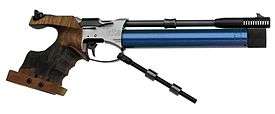
Pneumatic air guns propel the projectiles by utilizing the pneumatic potential energy within compressed air, which is pressurized beforehand and stored inside the gun, and then released through valves during shooting. Single-stroke and multi-stroke pump guns utilize an on-board pump to pressurize air in an internal reservoir, while pre-charged pneumatic guns' reservoirs are filled from an external source using either a high-pressure hand pump or by decanting air from a diving cylinder.
Pump pneumatic
Pump pneumatc air guns, or pump guns, use a lever-operated onboard air pump to pressurize an internal reservoir, which then discharge the stored compressed air during shooting. Depend on the design, pump guns can be either single-stroke or mult-stroke.
- In single-stroke pneumatic air guns, a single motion of the cocking lever is all that is required to mechanically compress the air. The single-pump system has always dominated the casual plinking market, and is usually found in target rifles and pistols, where the higher muzzle energy of a multi-stroke pumping system is not required. Single-stroke pneumatic rifles dominated the national and international ISSF 10 metre air rifle shooting events from the 1970s up to the 1990s.
- Multi-stroke pneumatic air guns use multiple pumpings to achieve variable power levels in order to adapt for both long or short-range shooting. This air gun are usually single-shot, which each shot requires approximately 5 strokes. However, up to five shots are possible, usually requiring around 10 to 20 strokes as long as the air reservoir is enough to store higher pressure. For safety reasons, most multi-stroke guns are usually designed to have its pump lever jammed when the reservoir has reached its maximum pressure limit, which the user can no longer pump the gun until it's discharged. The maximum pressure limit for the reservoir is approximately 20 to 30 strokes.
Pre-charged pneumatic
Pre-charged pneumatic (PCP) air guns have their internal reservoir pre-filled from an external air source (such as a diving cylinder, or by charging with a hand pump), and remains pressurized until depleted after repeated shooting. During shooting, the hammer strikes the reservior's release valve, allowing a set volume of the pressurized air to be discharged into the chamber and propel the projectile. Depending on the release valve design, PCP air guns can be categorized into two types — unregulated and regulated (which has either a mechanical or electronic regulator valve). Because of the need for cylinders or charging systems, PCP guns have higher initial costs but much lower operating costs when compared to CO2 rifles, and have superior performance over ordinary pump guns. Having no significant movement of heavy mechanical parts during the discharge cycle, PCP airgun designs produce lower recoil, and can shoot as many as 100 shots per charge depending on the tank/reservoir size.
The ready supply of air has allowed the development of semi- and fully automatic air guns.[7] PCP guns are very popular in the UK and Europe because of their accuracy and ease of use. They are widely utilized in ISSF 10 metre air pistol and rifle shooting events, the sport of Field Target shooting,[8] and are usually fitted with telescopic sights.
Early hand-pump designs encountered problems of fatigue (both human and mechanical), temperature warping, and condensation — none of which are beneficial to accurate shooting or the airguns' longevity. Modern hand pumps have built-in air filtration systems and have overcome many of these problems. Using scuba-quality air decanted from a scuba cylinder provides consistently clean, dry, high-pressure air.
During the typical PCP's discharge cycle, the hammer of the rifle is released by the sear to strike the bash valve. The hammer may move rearwards or forwards, unlike firearms where the hammer almost always moves forward. The valve is held closed by a spring and the pressure of the air in the reservoir. The pressure of the spring is constant, and the pressure of the air released (which is also known as the working pressure) decreases with each successive shot. As a result, when the reservoir pressure is high, the valve opens less fully and closes faster than when the reservoir pressure is lower, resulting in a similar total volume of air flowing past the valve with each shot. This results in a degree of partial self-regulation that gives a greater consistency of velocity from shot to shot, which corresponds to the middle "plateau" phase of the gun's shot-to-shot muzzle velocity profile (also known as the power curve ). A well-designed PCP will display good shot-to-shot consistency over longer period as the air reservoir is being depleted.
Other PCP rifles and pistols are regulated, i.e. the firing valve operates within a secondary chamber separated from the main air reservoir by the regulator body. The regulator maintains the pressure within this secondary chamber at a set pressure (lower than the main reservoir's) until the main reservoir's pressure drops to the point where it can no longer do so. As a result, shot-to-shot consistency is maintained for longer than in an unregulated rifle, and the gun can also output more shots due to reduced waste of reservoir pressure.
CO2
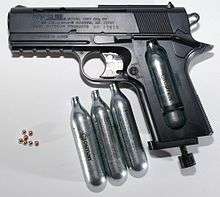
Originally called CG guns (compressed gas guns),[9] air guns utilizing prefilled removable gas cylinders as power source have now become known as CO2 guns due to the ubiquitous commercial use of bottled carbon dioxide gas. Most CO2 guns use a disposable cylinder called a "Powerlet", that is often purchased with 12 grams (0.42 oz) of pressurized CO2 gas, although some, usually more expensive models, use larger refillable CO2 reservoirs like those typically used with paintball markers.
CO2 guns, like other pneumatic guns using compressed air, offer power for repeated shots in a compact package without the need for complex cocking or filling mechanisms. The ability to store power for repeated shots also means that repeating arms are possible. There are many replica revolvers and semi-automatic pistols on the market that use CO2 power. These guns are popular for training, as the guns and ammunition are inexpensive, relatively safe to use, and no specialized facilities are needed for safety. In addition, they can be purchased and owned in areas where firearms possession is either strictly controlled or banned outright. Most CO2 powered guns are relatively inexpensive, and there are a few precision target guns available that use CO2.
Ammunition
Pellet
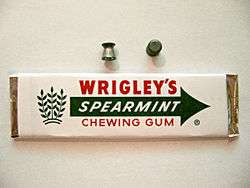
The most popular ammunition used in rifled air guns is the wasp-waisted diabolo pellet, which has two sections — a solid front portion called the "head", which contains the center of mass and is available in a variety of shapes and styles such as flat (wadcutter), round (domed), cone-shaped (pointed) and pitted (hollow point); and a hollowed, thin-walled rear portion called the "skirt", which expands and fully engages the bore to provide a good seal, thus allows maximal efficiency in pellet propulsion during shooting. In flight, the skirt has greater drag-to-weight ratio than the head, and provides drag-stabilization similar to that of a shuttlecock. This shape design also means that the overall pellet will have poor ballistic coefficient and tends to be more unstable than some other projectile shapes, especially in the transonic region (272–408 m/s ~ 893–1340 ft/s). Diabolo pellets are traditionally made from lead, but can also be manufactured from tin, or a combination of materials such as steel or gold alloys with polymer tips.
Slug
Some manufacturers also have recently introduced the more cylindrical-shaped "slug" pellets for the more powerful modern PCP air rifles. Compared to the commonly used diabolo pellets, these slug pellets resemble Minié balls and have more contact surface with the bore and hence needs greater propelling force to overcome friction, but have better aerodynamics and longer effective ranges due to the more similar shape to firearm bullets, however also require a fully rifled barrel for spin stabilization in flight.
BB
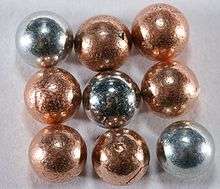
The BB was once the most common airgun ammunition in the USA, thanks to the popularity of Daisy’s line of BB airguns. A BB is a small metallic ball, typically made of steel (with a copper or zinc coating) or lead, in 4.5 mm/.177" diameter. Originally called the “round shot”, the contemporary name came from the “BB”- size lead birdshot used in shotguns, which the first BB gun invented in 1886 was designed to shoot. Steel BBs can be acceptably accurate at short distances when fired from properly designed BB guns with smoothbore barrels. Lead number 3 buckshot pellets can be used in .25" caliber airguns as if they were large BBs.
Due to the hardness of the steel, they can not "take" to rifled barrels, which is why they are undersized (4.4 against 4.5 mm) to allow them to be used in .177" rifled barrels, which when used in this configuration can in effect be considered smoothbore, but with a poorer gas-seal. Were they 4.5 mm diameter, they would jam in the bore. Therefore, BB's lack the spin stabilization required for long-range accuracy, and usage in any but the cheapest rifled guns is discouraged.
Typically BBs are used for indoor practice, casual outdoor plinking, training children, or for air gun enthusiasts who like to practice, but cannot afford high-powered air gun systems that use pellets. Some shotgunners use sightless BB rifles to train in instinctive shooting. Similar guns were also used briefly by the United States Army in a Vietnam-era instinctive shooting program called "Quick Kill".[10]
Darts and arrows
In the 18th and 19th centuries air gun darts were popular, largely because they could be reused. Although less popular now, several different types of darts are made to be used in air guns. But it is not recommended that darts be used in air guns with rifled bores or in spring-powered air guns.[11] Air guns that shoot darts are sometimes called dart guns, and tranquilizer guns if the darts used are loaded with anesthetic (tranquilizer) compounds.
Some modern air guns are designed to discharge arrows and are called arrow guns or sometimes airbows. These arrows are designed with a hollow shaft that is open in the rear where the nock would normally be. When loaded, the hollow arrow shaft is slid rearwards over a barrel whose external diameter is only fractionally smaller than the shaft's interior diameter, providing a close enough fitting that minimizes rattling and gives reasonable enveloping seal without causing too much friction. During shooting, the trigger releases high-pressure air from the barrel to the front portion of the hollow arrow shaft, pushing the arrow forward. Such air guns can shoot arrows at launch velocities rivalling or even exceeding high-end crossbows, while retaining consistency of precision unaffected by archer's paradox, but they are also more expensive to setup and maintain.
Calibers
The most common air gun calibers are
- .177 (4.5 mm): the most common caliber. Mandated by the ISSF for use in international target shooting competition at 10m, up to Olympic level in both rifle and pistol events. It has also been adopted by most National Governing Bodies for domestic use in similar target shooting events. It has the flattest trajectory of all the calibers for a given energy level, making accuracy simpler. At suitable energy levels it can be used effectively for hunting.
- .22 (5.5 mm & 5.6 mm): for hunting and general use. In recent years air rifles and pistols in .22" (and some other calibers) have been allowed for use in both domestic and international target shooting in events not controlled by the ISSF. Most notably in FT/HFT and Smallbore Benchrest competitions. These events often allow the use of any caliber air gun, up to a maximum which is often .22", rather than a fixed caliber.
Other less common traditional calibers include:
- .20 (5 mm): initially proprietary to the Sheridan multi-pump pneumatic air rifle, later more widely used.
- .25 (6.35 mm): the largest commonly available caliber for most of the 20th century.
- .30 (7.62 mm): the current largest available for non-PCP powered airguns
Larger caliber air rifles suitable for hunting large animals are offered by major manufacturers. These are usually PCP guns. The major calibers available are:
- .357
- .45 (11.43 mm)
- .50 (12.7 mm)
- .58 (14.5 mm)
Custom air guns are available in even larger calibers such as 20 mm (0.79") or .87 (22.1 mm).
Legislation
While in some countries air guns are not subject to any specific regulation, in most there are laws, which differ widely. Each jurisdiction has its own definition of an air gun; and regulations may vary for weapons of different bore, muzzle energy or velocity, or material of ammunition, with guns designed to fire metal pellets often more tightly controlled than airsoft weapons. There may be minimum ages for possession, and sales of both air guns and ammunition may be restricted. Some areas require permits and background checks similar to those required for proper firearms.
Safety and misuse
While historical air guns have been made specifically for warfare, modern air guns can also be deadly.[12] In medical literature, modern air guns have been noted as a cause of death.[13][14][15] This has been the case for guns of caliber .177 and .22 that are within the legal muzzle energy of air guns in the United Kingdom.[16]
See also
References
- ↑ Schreier, Philip (October 2006). "The Airgun of Meriwether Lewis". American Rifleman. Retrieved 23 December 2013.
- ↑ Arne Hoff, Airguns and Other Pneumatic Arms, Arms & Armour Series, London, 1972
- ↑ L.Wesley, Air Guns and Air Pistols, London 1955
- ↑ H.L.Blackmore, Hunting Weapons, London 1971
- ↑ Laidlaw, Angus (January 2014). "Chicago Air Rifle Markham's Patent". American Rifleman. 162 (1): 48.
- ↑ Ben Saltzman. "The Three Basic Types of Airguns". American Airguns. Archived from the original on 15 October 2007. Retrieved 2007-09-14.
- ↑ "Air Ordnance Full Auto Pellet Gun". Archived from the original on 2014-12-03. Retrieved 28 November 2014.
- ↑ "American Airgun Field Target Association". Retrieved 28 November 2014.
- ↑ Tom Gaylord. "CO2 is used to power many air guns". PyramydAir. Retrieved 2017-01-15.
- ↑ Time magazine, Friday, July 14, 1967
- ↑ "Airgun projectiles". Retrieved 1 June 2017.
- ↑ "Crackdown on killer air rifles". NZPA. 14 July 2010. Retrieved 15 September 2011.
- ↑ Kuligod, FS; Jirli, PS; Kumar, P. "Air gun--a deadly toy?: A case report". Med Sci Law. 46: 177–80. PMID 16683474.
- ↑ Lawrence, HS. "Fatal nonpowder firearm wounds: case report and review of the literature". Pediatrics. 85: 177–81. PMID 2104975.
- ↑ "Air weapon injuries: a serious and persistent problem".
- ↑ Milroy, CM; Clark, JC; Carter, N; Rutty, G; Rooney, N (1998). "Air Weapon Fatalities" (PDF). J. Clin. Pathol. 51: 525–9. doi:10.1136/jcp.51.7.525. PMC 500806. PMID 9797730.
External links
| Wikimedia Commons has media related to Air guns. |